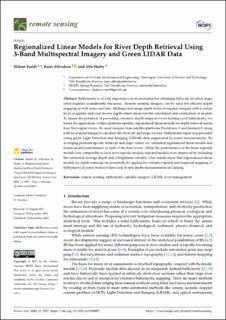| dc.contributor.author | Sundt, Håkon | |
| dc.contributor.author | Alfredsen, Knut | |
| dc.contributor.author | Harby, Atle | |
| dc.date.accessioned | 2021-11-16T13:18:18Z | |
| dc.date.available | 2021-11-16T13:18:18Z | |
| dc.date.created | 2021-09-29T18:12:39Z | |
| dc.date.issued | 2021 | |
| dc.identifier.citation | Remote Sensing. 2021, 13 (19), . | en_US |
| dc.identifier.issn | 2072-4292 | |
| dc.identifier.uri | https://hdl.handle.net/11250/2829877 | |
| dc.description.abstract | Bathymetry is of vital importance in river studies but obtaining full-scale riverbed maps often requires considerable resources. Remote sensing imagery can be used for efficient depth mapping in both space and time. Multispectral image depth retrieval requires imagery with a certain level of quality and local in-situ depth observations for the calculation and verification of models. To assess the potential of providing extensive depth maps in rivers lacking local bathymetry, we tested the application of three platform-specific, regionalized linear models for depth retrieval across four Norwegian rivers. We used imagery from satellite platforms Worldview-2 and Sentinel-2, along with local aerial images to calculate the intercept and slope vectors. Bathymetric input was provided using green Light Detection and Ranging (LIDAR) data augmented by sonar measurements. By averaging platform-specific intercept and slope values, we calculated regionalized linear models and tested model performance in each of the four rivers. While the performance of the basic regional models was comparable to local river-specific models, regional models were improved by including the estimated average depth and a brightness variable. Our results show that regionalized linear models for depth retrieval can potentially be applied for extensive spatial and temporal mapping of bathymetry in water bodies where local in-situ depth measurements are lacking | en_US |
| dc.language.iso | eng | en_US |
| dc.publisher | MDPI | en_US |
| dc.rights | Navngivelse 4.0 Internasjonal | * |
| dc.rights.uri | http://creativecommons.org/licenses/by/4.0/deed.no | * |
| dc.title | Regionalized Linear Models for River Depth Retrieval Using 3-Band Multispectral Imagery and Green LIDAR Data | en_US |
| dc.type | Peer reviewed | en_US |
| dc.type | Journal article | en_US |
| dc.description.version | publishedVersion | en_US |
| dc.rights.holder | The Authors | en_US |
| dc.source.pagenumber | 22 | en_US |
| dc.source.volume | 13 | en_US |
| dc.source.journal | Remote Sensing | en_US |
| dc.source.issue | 19 | en_US |
| dc.identifier.doi | https://doi.org/ 10.3390/rs13193897 | |
| dc.identifier.cristin | 1940840 | |
| dc.relation.project | Norges forskningsråd: 257588 | en_US |
| dc.source.articlenumber | 3897 | en_US |
| cristin.ispublished | true | |
| cristin.fulltext | original | |
| cristin.qualitycode | 1 | |

